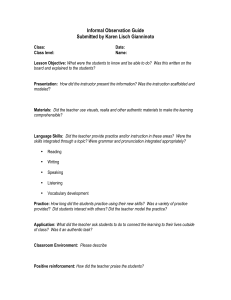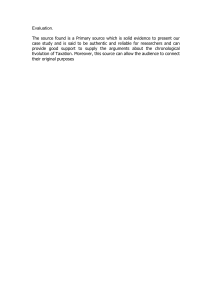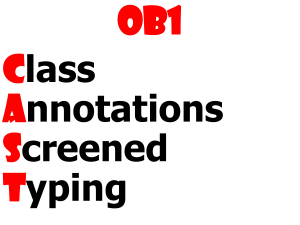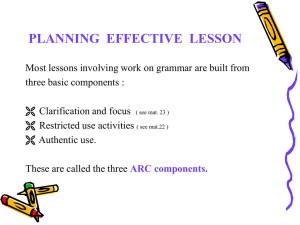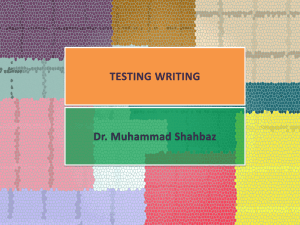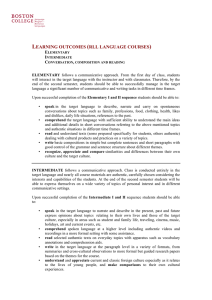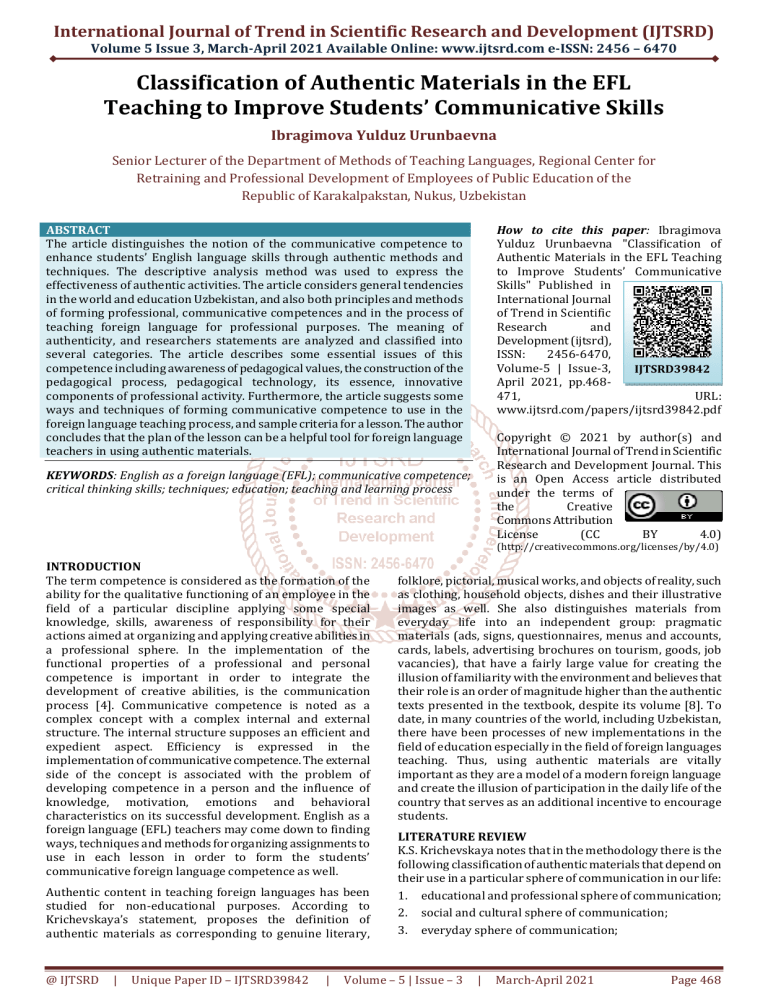
International Journal of Trend in Scientific Research and Development (IJTSRD)
Volume 5 Issue 3, March-April 2021 Available Online: www.ijtsrd.com e-ISSN: 2456 – 6470
Classification of Authentic Materials in the EFL
Teaching to Improve Students’ Communicative Skills
Ibragimova Yulduz Urunbaevna
Senior Lecturer of the Department of Methods of Teaching Languages, Regional Center for
Retraining and Professional Development of Employees of Public Education of the
Republic of Karakalpakstan, Nukus, Uzbekistan
How to cite this paper: Ibragimova
Yulduz Urunbaevna "Classification of
Authentic Materials in the EFL Teaching
to Improve Students’ Communicative
Skills" Published in
International Journal
of Trend in Scientific
Research
and
Development (ijtsrd),
ISSN:
2456-6470,
Volume-5 | Issue-3,
IJTSRD39842
April 2021, pp.468471,
URL:
www.ijtsrd.com/papers/ijtsrd39842.pdf
ABSTRACT
The article distinguishes the notion of the communicative competence to
enhance students’ English language skills through authentic methods and
techniques. The descriptive analysis method was used to express the
effectiveness of authentic activities. The article considers general tendencies
in the world and education Uzbekistan, and also both principles and methods
of forming professional, communicative competences and in the process of
teaching foreign language for professional purposes. The meaning of
authenticity, and researchers statements are analyzed and classified into
several categories. The article describes some essential issues of this
competence including awareness of pedagogical values, the construction of the
pedagogical process, pedagogical technology, its essence, innovative
components of professional activity. Furthermore, the article suggests some
ways and techniques of forming communicative competence to use in the
foreign language teaching process, and sample criteria for a lesson. The author
concludes that the plan of the lesson can be a helpful tool for foreign language
teachers in using authentic materials.
Copyright © 2021 by author(s) and
International Journal of Trend in Scientific
Research and Development Journal. This
is an Open Access article distributed
under the terms of
the
Creative
Commons Attribution
License
(CC
BY
4.0)
KEYWORDS: English as a foreign language (EFL); communicative competence;
critical thinking skills; techniques; education; teaching and learning process
(http://creativecommons.org/licenses/by/4.0)
INTRODUCTION
The term competence is considered as the formation of the
ability for the qualitative functioning of an employee in the
field of a particular discipline applying some special
knowledge, skills, awareness of responsibility for their
actions aimed at organizing and applying creative abilities in
a professional sphere. In the implementation of the
functional properties of a professional and personal
competence is important in order to integrate the
development of creative abilities, is the communication
process [4]. Communicative competence is noted as a
complex concept with a complex internal and external
structure. The internal structure supposes an efficient and
expedient aspect. Efficiency is expressed in the
implementation of communicative competence. The external
side of the concept is associated with the problem of
developing competence in a person and the influence of
knowledge, motivation, emotions and behavioral
characteristics on its successful development. English as a
foreign language (EFL) teachers may come down to finding
ways, techniques and methods for organizing assignments to
use in each lesson in order to form the students’
communicative foreign language competence as well.
Authentic content in teaching foreign languages has been
studied for non-educational purposes. According to
Krichevskaya’s statement, proposes the definition of
authentic materials as corresponding to genuine literary,
@ IJTSRD
|
Unique Paper ID – IJTSRD39842
|
folklore, pictorial, musical works, and objects of reality, such
as clothing, household objects, dishes and their illustrative
images as well. She also distinguishes materials from
everyday life into an independent group: pragmatic
materials (ads, signs, questionnaires, menus and accounts,
cards, labels, advertising brochures on tourism, goods, job
vacancies), that have a fairly large value for creating the
illusion of familiarity with the environment and believes that
their role is an order of magnitude higher than the authentic
texts presented in the textbook, despite its volume [8]. To
date, in many countries of the world, including Uzbekistan,
there have been processes of new implementations in the
field of education especially in the field of foreign languages
teaching. Thus, using authentic materials are vitally
important as they are a model of a modern foreign language
and create the illusion of participation in the daily life of the
country that serves as an additional incentive to encourage
students.
LITERATURE REVIEW
K.S. Krichevskaya notes that in the methodology there is the
following classification of authentic materials that depend on
their use in a particular sphere of communication in our life:
1. educational and professional sphere of communication;
2. social and cultural sphere of communication;
3. everyday sphere of communication;
Volume – 5 | Issue – 3
|
March-April 2021
Page 468
International Journal of Trend in Scientific Research and Development (IJTSRD) @ www.ijtsrd.com eISSN: 2456-6470
4.
5.
6.
trade and commercial sphere of communication;
family and household communication environment;
sports and recreation sphere of communication [8].
According to Voronina, this classification given is identical to
the definition of authentic materials given who in turn
defines authentic texts as texts that are taken from the
communicative practice of native speakers. She identified
two types of authentic texts that are presented in different
genre forms in the following: 1) functional: advertising,
instructive, explanatory or warning function (signs, theater
programs, diagrams, road signs, drawings); 2) informative
that performs information function containing information
that is constantly updated (topical sensational information,
announcements, letters from readers to print media, articles,
interviews, explanations for statistics, graphics,
commentary) [5].
When we analyzed the notion of authentic materials we
came up with the statements in the following: Kirienko
assumes that it is considered to be an authentic text that was
initially unsuitable for educational purposes, that is a text
written for native speakers by the native speakers of this
language [6]. On the other hand, our methodologists note
that authentic materials that are produced for native
speakers that are actually original texts created for real
conditions.
We may come across with a question in the following: are
inauthentic materials (when they are far from the real
language) can make the learners good listeners, readers and
speakers? Thus, it can be more preferable to teach the
foreign language using authentic materials that are materials
taken from original sources and were not intended for
educational purposes.
However, Milrud notes that there are some disadvantages of
such materials that are complex in the linguistic aspect and
may not always correspond to specific tasks and learning
conditions, highlighting methodological authentic texts.
Authentic educational texts should be understood as texts
compiled by the authors of the teaching materials that take
into consideration all the parameters of authentic
educational production that can be presented in summary
tables. Milrud developed the following parameters authentic
educational text that considers a set of structural features of
such a text that meets the norms that are accepted by native
speakers [11]. A text is an authentic that is characterized by
the naturalness of the lexical content and grammatical forms,
the situational adequacy of the linguistic means and
demonstrates with the help of illustrations as well.
METHODOLOGY
A question might be arisen: Are authentic materials should
be used only in teaching reading and listening? Also, how
might this affect the students? If we suppose that we gave
students at the elementary level a page from Ch. Dickens’
work or an article from a daily/weekly newspaper. They may
not understand these texts and might be disappointed with
it. However, students may also get frustrated when they
faced with light texts. Thus, extreme positions should not be
used in the educational process and both authentic and
inauthentic texts should be placed in textbooks. On the
contrary, all of them should be understandable to students,
and correspond to their language competence reflecting
realistic models of written or spoken language as well.
@ IJTSRD
|
Unique Paper ID – IJTSRD39842
|
According to Milrud and Nosonovich’s, authentic materials
include: articles, advertisements, recipes, short stories/tales,
personal letters, interviews, regional and popular science
texts, short extracts/passages from writers’ diaries [1, 11].
They include authenticity of the genre and the fact that
genre-compositional diversity allows students to familiarize
themselves with speech cliché, vocabulary, phraseologisms
that are associated with different spheres of life and belong
to different styles. Justifying the use of authentic texts that
are intended for the native speakers themselves, Milrud
emphasizes substantive aspects of authenticity in the
following:
1. Authenticity of assignments to texts is that study
assignments should stimulate interaction with the text,
and should be based on the sources of information;
2. Authentic design is that grabs attention students and
thereby simplifies understanding of a communicative
task, the text and the establishment of its links with
reality;
3. Reactive authenticity is the development of educational
text that it needs to be given the ability to evoke in
students an authentic mental, emotional and speech
response;
4. Situational authenticity implies reality of the situation
that is offered as an educational illustration, interest
native speakers to this topic, simplicity of its discussion;
5. Informative authenticity is that the use of texts that
provide learners with meaningful information that
corresponds to their interests and age characteristics;
6. Cultural authenticity that is using texts that form the
students’ idea of the specifics of another culture, habits
and attitudes of native speakers;
7. Authenticity of national mentality that is able to explain
to students the appropriateness or inappropriateness
use of a particular phrase or word.
Therefore, there is no universal and complete definition of
authenticity. Authentic materials can be defined as those
materials that were created by native speakers for native
speakers for non-educational purposes, corresponding to
original literary, folklore, visual, musical works, as well as
real-life objects such as furniture, clothing, dishes and their
illustrative images. In the methodology, there is the
following classification of pragmatic (authentic) materials,
depending on their use in a particular area and sphere of
communication in our life:
1. Educational and professional sphere of communication;
2. Social and cultural sphere of communication;
3. Everyday sphere of communication;
4. Trade and commercial sphere of communication;
5. Family and household communication environment;
6. Sports and recreation sphere of communication.
Authentic texts are characterized by the originality of lexical
content in linguistic aspect. The sociocultural background of
authentic materials is realized through a productive
vocabulary that includes the most significant lexical units
that are common in daily conversations, situations, including
evaluative vocabulary to express opinion, colloquial cliches
and words related to a national-cultural component. The
authenticity of educational material is a relative property
that depends on a number of factors. Such factors may be the
conditions in which the given educational material is applied
and the individual characteristics of students, the goals of
the teacher as well.
Volume – 5 | Issue – 3
|
March-April 2021
Page 469
International Journal of Trend in Scientific Research and Development (IJTSRD) @ www.ijtsrd.com eISSN: 2456-6470
RESULTS AND DISCUSSION
The specialists identified major reasons that determine the
necessity of using authentic materials during the lesson: a)
using authentic materials, students learn the language for
live communication; b) authentic materials correspond to
the interests of students having a positive impact on the
motivation of students; c) increase of teaching efficiency; d)
authentic materials introduce students to the culture of the
target language [10].
In other words, authentic materials can help to overcome the
language barrier taught in the lesson and the language that
people use to communicate in certain real life situations.
Authentic texts in their original form are unsuitable for
educational purposes. For this reason, they should be
subjected to didactic manipulation. These manipulations
could be: processing of the structure and linguistic forms of
the text, its combination with other educational materials,
the provision in a foreign language environment can violate
its authenticity as well. In order for students to recognize the
text in a real situation, it is necessary to preserve the
identifying features of the original text taking into account
the criteria for its authenticity that are: the addressee, the
purpose of the message, the external form, environment,
code and tonality. The text that was chosen as a teaching
material, can be processed by: a) removing one complete
part from the whole, for example: an interview from a
television program; b) using the collage technique; c)
segmentation; d) reduction; e) drawing up an annotation; f)
omissions, additions, substitutions, separate words; g)
replacing difficult grammatical forms; h) simplification by
removing the characters and details.
On the other hand, it is significant to take into account the
ratio of difficulty and accessibility of the text for the learners.
During the preparation of the text, it is important to know
the dosage of unfamiliar material in order to avoid
information overload. The text should contain authentic
speech that becomes more complex as the time goes. From
the teaching experience we can note that students develop
comprehension more quickly if they are convinced that
comprehension does not require decoding verbatim. In
order to save time, it is recommended to subject text didactic
processing that are not very tied to the current topics of the
day, so that they can be used for a long time in the learning
process. In the following, techniques of working with
authentic letters are given:
Stage II. Reading.
1. Reading for comprehension. After reading the letter,
answer the following questions: a) from whom it is; b) what
it is about?
2. Reading with extract (partial) information. After reading
the letter, answer the questions.
3. Reading with full understanding. After reading the letter:
a) answer the question about the content of the text; b)
finish the sentence; c) say the sentence is right or wrong; d)
correlate the beginning and end of the sentence; e) correct
the wrong options; f) retell the letter.
Stage III. Speaking.
Do you have a pen friend? Tell us about your pen friend. Ask
your partner about his pen pal. Retell the letter. Convey the
content of the letter in indirect speech.
Stage IV. Grammar of speech. Write down all the verbs.
Determine the tense form.
a) Retell in indirect speech; b) Ask questions about the
proposal; c) Write out adjectives, form degrees of
comparison; d) Correct mistakes; e) Find offers at a specific
time; f) Transform sentences into passive voice; g) Rewrite
the paragraph, replacing adjectives (or changing verbs) with
synonyms.
Stage V. Letter writing. Practice writing a letter. After
reviewing the letter forms, answer the following questions:
a) How do I start a letter? b) How to prepare a letter? c)
Where is the date written? d) What phrases does the letter
end with? e) Are abbreviations allowed in the letter? f) How
is an official letter different from an unofficial one? g) How is
the text divided into paragraphs? h) Determine the nature of
each letter (personal, business, complain letter, letter of
gratitude, letter invitation, congratulation extraction) i)
Write a letter according to the proposed plan. j) Rewrite the
letter in an abbreviated form (by summarizing content).
2. Listening with the extraction of partial information. After
listening to the letter, answer the following questions.
CONCLUSION
Thus, the following criteria for the selection of authentic
materials for practical lessons in the foreign language
(English as a foreign language): a) criterion of thematic
correlation; b) the criterion of orientation towards the
modern reality of the country of the target language; c) a
criterion for taking into account age characteristics and
cognitive capabilities of students; d) the criterion of
obligation that determines the selection of the information
minimum about works of painting, literature, history that
are necessary for every culture; e) criterion of educational
value; f) criterion of novelty [9]. Therefore, we can see that
authentic materials have more advantages in comparison
with inauthentic such as the ability of authentic materials to
help students prepare for a real life communication, they
reflect national specifics, arouses interest among students,
authentic materials illustrate functioning in a natural social
context and also help make the lesson unusual vivid and
memorable that will contribute to a better memorization of
lexical units, grammatical structures and of the target
language.
3. Listening to detailed information with the extraction. After
listening to the letter, do the following tasks: a) answer
questions about the content of the text; b) finish sentences;
c) correlate the beginning and end of phrases; d) answer
correctly or the sentence is incorrect; e) correct the wrong
(incorrect) options; f) retell the content chain.
We also found out that it is possible to achieve the formation
of the communicative foreign language competence of
students in different ways. For example, using the group
form of learning activities, the project method, assignments
that can provide for the development of critical thinking,
logical thinking of students. For example: an essay,
Warm up: 1) Have you ever written a letter to someone? 2)
If yes, when did you write it and why?/ To whom? 3) What
types of letters do you know? (Formal, Informal,
Transactional)
Stage I. Listening.
1. Listening for comprehension. After listening to the letter,
answer the questions: a) What do you think the letter is from
…; b) What is the subject of the letter; c) When the letter is
written.
@ IJTSRD
|
Unique Paper ID – IJTSRD39842
|
Volume – 5 | Issue – 3
|
March-April 2021
Page 470
International Journal of Trend in Scientific Research and Development (IJTSRD) @ www.ijtsrd.com eISSN: 2456-6470
discussion, dialogue, role play. Also, using information and
communication technologies and the Internet are a means of
communicative tools and techniques. It was also revealed
that when selecting authentic materials for assignment in the
foreign language lesson, it is worth adhering to criteria that
were stated above. The presented methods and forms of
working with authentic materials could be used to work in
the classroom, including in the English as a foreign language
classes.
References
[1] E. V. Nosonovich, Content Authenticity Criteria
educational text [Text] / E. V. Nonsovich, I. P. Milrud
// Foreign languages at school, 2009. No. 2. pp. 6-12.
[2]
[3]
[4]
E. G. Khrisanova, Pedagogical conditions of formation
foreign language communicative competence among
students of specialized classes, // Kazan pedagogical
journal, No 2. 2010.
E. N. Radchenko, Teaching business foreign language
communication at an advanced stage of learning a
foreign language, // Bulletin of Chit. GU № 1 (42).
2007. pp. 23-29.
E. A. Lomakina, Formation of communicative
competence in teaching a professionally oriented
foreign language, // Foreign languages: linguistic and
methodological aspects, Tver state university, Tver.
2018. No. 41, pp. 39-44.
@ IJTSRD
|
Unique Paper ID – IJTSRD39842
|
[5]
G. I. Voronina, Organization of work with authentic
texts youth press in the senior grades of schools with
in-depth study of a foreign language // Foreign
languages at school, 2009. No. 2. pp. 23-25.
[6]
I. V. Kireenko, Authentic text in teaching foreigners
languages // New science: problems and prospects,
2015. pp. 33-38.
[7]
J. C. Richard, Curriculum development in language
teaching, [Текст] / J. C. Richards. Cambridge:
Cambridge University Press, 2011. pp. 336.
[8]
K. S. Krichevskaya, Pragmatic materials introducing
students with the culture and habitat of the
inhabitants of the country of the studied language //
Foreign languages at school, 2008. No. 1. pp. 13-17.
[9]
L. E. Smirnova, Selection of authentic materials for
practical lessons in a foreign language //
International scientific journal Innovative Science,
2016. No. 4. pp. 15-21.
[10]
M. Peacock, The Effect of Authentic Materials on the
Motivation of EFL Learners // ELT Journal. 2008. №
51 (2). pp. 144-156.
[11]
R. P. Milrud, E. V. Nosonovich, Criteria for meaningful
the authenticity of the educational text // Foreign
languages at school, 2009. No. 2. pp. 8-12.
Volume – 5 | Issue – 3
|
March-April 2021
Page 471

